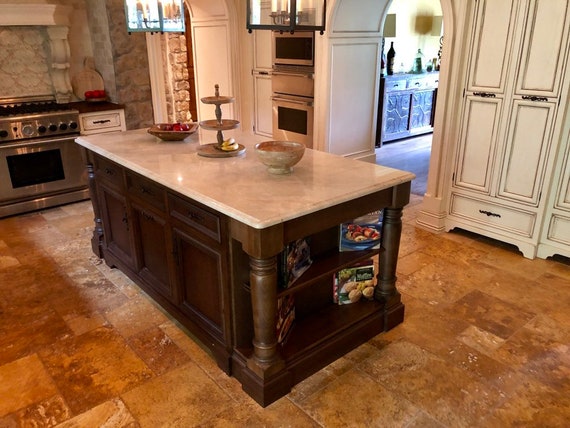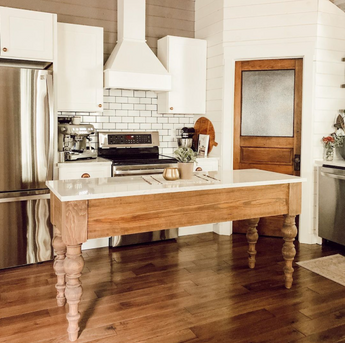The Top Kitchen Island Leg Styles to Enhance Any Type Of Layout Aesthetic
The Top Kitchen Island Leg Styles to Enhance Any Type Of Layout Aesthetic
Blog Article
Checking Out the Important Functions of a Kitchen Area Island Leg for Your Culinary Area
The kitchen area island offers as a central hub in any kind of culinary space, and the choice of leg design is essential in boosting both its capability and aesthetic allure. Comprehending the vital features of kitchen island legs-- including product choices, style styles, and security variables-- can dramatically influence the general experience within the kitchen.
Importance of Cooking Area Island Legs
Cooking area island legs play a critical role in both the performance and looks of a cooking area space. They not just support the weight of the island yet likewise enhance the general style, adding to the cooking area's visual charm. The choice of legs can determine the design of the kitchen area, be it modern, traditional, or rustic.
Functionally, durable and appropriately developed legs make certain security, enabling for the secure usage of the island for different jobs such as cooking, dining, or amusing. Strong legs stop changing and tottering, providing a trusted surface area for daily tasks.
Moreover, the elevation and positioning of the legs can influence the convenience level for those seated at the island. A well-considered elevation can fit bar stools or chairs, advertising an inviting environment for events.
In addition to these functional factors to consider, kitchen island legs can work as a centerpiece in the room (kitchen island leg). Decorative or distinctively designed legs can boost the style aesthetic, making the island a centerpiece. Hence, picking the best kitchen area island legs is important for balancing form and feature in any type of culinary room
Product Options for Legs
Picking the proper material for cooking area island legs substantially impacts both toughness and layout. Common material alternatives consist of wood, rock, and steel, each offering unique advantages.
Wood is a popular option due to its warmth and convenience. It can be easily personalized to match numerous decor styles, from rustic to modern. Hardwoods like oak and maple offer exceptional stamina and longevity, while softer timbers can be extra susceptible to tear and wear.
Metal legs are preferred for their sleek, modern-day aesthetic. kitchen island leg. Stainless-steel and light weight aluminum are not just robust yet additionally resistant to corrosion and corrosion, making them perfect for kitchen area environments. They can develop a commercial look and are usually available in different coatings to complement other cooking area aspects
Stone legs, such as granite or marble, add a component of high-end and stability. While heavier than various other products, they offer phenomenal durability and can stand up to substantial weight. They might need extra assistance to make sure appropriate equilibrium.
Ultimately, the choice of material should line up with both functional needs and the general layout vision of the kitchen area area, making certain that the island legs boost both energy and appearances.
Design Styles to Take Into Consideration
What design styles should be considered when choosing legs for a cooking area island? The selection of leg style dramatically influences the overall visual of your culinary area. For a contemporary kitchen, minimalistic and sleek leg layouts, such as stainless steel or geometric forms, can improve the modern-day allure, providing a tidy and minimalist look.
On the other hand, conventional kitchen areas take advantage of classic designs such as transformed or sculpted wood legs, which add heat and character. These choices frequently feature complex information that enhance vintage furnishings. For a rustic ambiance, think about legs made from recovered wood or wrought iron, which bring an organic, natural quality to the space.
If you lean towards a commercial theme, robust metal legs with a distressed additional info finish may be excellent, supplying an edgy yet sophisticated touch. Additionally, farmhouse design kitchens can include chunky legs that evoke a feeling of sturdiness and homeliness.

Elevation and Stability Factors
The height and security of a kitchen island are essential components that straight affect its performance and customer experience. An ideal kitchen island leg should provide sufficient elevation to accommodate a selection of jobs, from food preparation to casual dining. Typically, cooking area islands stand between 36 to 42 inches tall, lining up with conventional counter and bar elevations. This array ensures convenience for users while executing different tasks, therefore improving the general functionality of the room.
Security is just as important, especially as cooking area islands frequently serve as focal factors in cooking settings. The leg's add-on to the island's base need to be safe and secure, making certain durability and strength against the wear and tear of everyday use.
Modification and Accessories
Customization choices and devices for kitchen area island legs can significantly improve both the aesthetic allure and capability of the space. Home owners can select from a variety of materials, recommended you read including stone, metal, and wood, enabling smooth assimilation with existing kitchen decor. The selection of surface-- be it an all-natural discolor, paint, or powder coating-- additional customizes the look, making sure that the island matches the general layout style.
Along with product and coating, homeowners may also discover the consolidation of devices such as attractive brackets, flexible feet, or integrated shelving. Braces can offer extra support while contributing to a modern or rustic visual. Flexible feet are specifically helpful for irregular flooring, making certain the island remains secure and level, which is critical for both safety and functionality.

Final Thought
In final thought, kitchen island legs serve a crucial role in providing security and boosting the total aesthetic of the culinary area. Personalization options and devices can elevate the kitchen area island, making it a distinct focal point within the home.
The kitchen island offers as a main center in any kind of culinary space, and the option of leg style is essential in boosting both its functionality you can find out more and visual charm. Understanding the necessary functions of cooking area island legs-- consisting of material options, design styles, and stability variables-- can dramatically affect the total experience within the cooking area.Cooking area island legs play a crucial role in both the capability and looks of a cooking area area.What style styles should be considered when choosing legs for a kitchen island?In conclusion, cooking area island legs offer a crucial role in providing security and enhancing the total visual of the cooking area.
Report this page